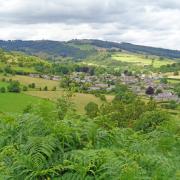Exploring Rough Side in Coombs Dale, and a lagoon rich in birdlife
This is a walk through a landscape of quarries, shafts, rakes and opencast workings, mostly returning to nature. It takes the rambler down through Rough Side, a deep-cut dale of ash and hazel, scattered with wildflowers in spring and summer.
A narrow path climbs out of the steep-sided valley to reveal wide-open views of Eyam, Baslow, Curbar and Froggatt edges with the higher reaches of the Dark Peak beyond.
The last stretch follows the edges of a lagoon that’s home to an array of waterbirds. If you arrive at dusk between October and March, you may well be rewarded with one of nature’s most stunning displays: a starling murmuration.
The route
1. Follow the wide track below Middleton Moor towards an old quarry site, now used to settle limestone slurry, and simply named lagoon 4.
It may not sound glamorous but the reedbeds and bulrushes are paradise for roosting starlings, waders and other birds that favour wetlands. Continue to round the north and eastern fringes of the lagoon until you meet Black Harry Gate and a crossroads of pathways and bridleways.

2. Ignoring Black Harry Lane on the left, continue down into the dale of Rough Side, a deep cutting on the eastern fringes of Middleton Moor.
In winter and spring after heavy rains, water oozes out of springs, sometimes flowing in channels alongside the wide, stony limestone path, occasionally disappearing underground before turning the pathway into a shallow river - fun to splash through in wellies.
It’s hard to imagine this landlocked dale is made up of fossil-rich limestone deposits that once lay under the warm, shallow waters of the Carboniferous period, some 330 million years ago. Nowadays, the sheer-sided walls of the dale are brightly splashed with colourful fauna through spring and summer - including rock-rose, wild thyme, bloody cranesbill, lily-of-the-valley, cowslip and orchids.
3. Keep your eyes peeled for a wooden bridge on the right where Coombs Dale meets the upper section of Rough Side. Almost immediately, another right heads up the dale-side, back in the direction from which you’ve come.
Watch your footing on the narrow path that cuts across the hillside, the sheer-sided slope plunging to the valley floor beneath your feet. A wooden gate at the top of the dale takes the rambler through meadow, past a dewpond, before emerging at Bleaklow Farm and a working quarry.
4. Here, where five pathways meet, head west to follow the wide track over the meadows above Rough Side, now out of sight. The path emerges just above Black Harry Gate.
Ignoring the quarry track (with its no trespassing signs) go through a gate on the right of it and turn left to follow a path that runs parallel to the forbidden quarry road.

5. Look out for a fingerpost on your left along the dry-stone wall. Turn right here to climb up through the meadow of Blakedon Hollow.
Ahead is another drystone wall with a footpath sign at its corner. Keep right of the wall, before climbing steps over another wall, crossing a stile with the lagoon now to your right.
Follow the fenced edge of a copse around the lagoon area. The curious blue barrels around the lagoon are filled with birdseed.
6. Look out for a stile in the fence on your right that drops through the small woodland to a bird hide. This is a great place to open the hide flaps and scan the reedbeds and water for avian activity.
In winter at dusk, hundreds and thousands of starlings sometimes gather here to fly in tight formation above the lagoon, creating ever-changing shapes in the sky - darkening and lightening as they spread out and come together again. Unscrew your flask, enjoy a hot drink and a snack, and wait patiently.
Murmurations are not guaranteed, as the starlings move further south if it’s too cold or icy. If neither the starlings nor wetland birds deliver, enjoy the records of bird sightings listed in the notebooks hanging from the wall.
The spring entries reads like a birder’s wish-list. Canada goose, lapwing, oystercatcher, redshank, curlew, teal, shelduck, wigeon, golden plover and red bunting have all been spotted at Lagoon 4.
The path skirts the rest of the reedbeds and filled-in ponds (more opportunity for birdwatching) before emerging on the main quarry lane again.

7. Climb the style and turn left on the track to reach your starting point.
At a glance
Distance: 4.4 miles
Map: OS Explorer Map OL24, White Peak
Difficulty: Medium to challenging
Getting there: To reach the start of the walk take the B6465 from the A623 at Wardlow Mires to Wardlow. Turn left in the village and drive right at the next junction. You will see the quarry lane on the bend of the road.
Parking: There are a few roadside spaces at this end of the unmetalled lane – SK 1934 7449.
Refreshments: None. Pack a picnic and enjoy a ‘chew with a view’ in the shelter of the lagoon bird hide. Be sure to leave no trace behind you.
Easy alternative: You can shorten the walk to do a loop of the lagoon, a fairly level ramble.


























